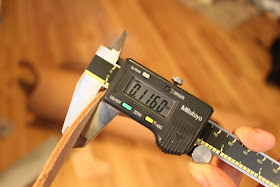Note: This post isn't really about 16th century methodologies.
I've shared a few of my favorite "hacks" (as the kids say) for making leather items with a bit of improvisation in the tools department. We've used flower pots to build mugs, we've used butter knives for skiving, and my favorite cheap woodworking chisels for cutting.
So let's talk about pattern making.
If you've ever followed my maskmaking tutorial or done any other leatherworking without a pre-printed pattern, you've noticed that there's often a size discrepancy between any paper pattern you've created by wrapping the item in paper and marking seams (as we did with this shoemaking post) and the leather you're going to use.
This can cause some real fit issues.
The problem stems from the difference in thickness between paper and leather, combined with the fact that paper doesn't stretch around a form and leather does. You could use some math to account for the thickness, but the stretch is a bit more difficult to guess at, which can result in some wasted materials.
Here's my Not Even Remotely Period (NERP) approach to leather patterning that saves me a lot of time and leather when I'm winging it with a pattern: craft foam.
In the image below, I am preparing a knife sheath for one of my carving knives. I've wrapped the knife in paper and marked the seam, but to get a better handle on the actual shape of the final piece of leather, I made the pattern in the back on thin white foam which I purchased from a local Michael's craft store.
It's not quite as thick as the final leather, but it's close. More importantly, it stretches a bit in a manner that is very reminiscent of damp leather. And since this is a pattern where the fit is precise and the seams have to just meet with no seam allowance, fit is so very crucial.
It's NERPy, sure, but it works a treat.
- Scott



No comments:
Post a Comment